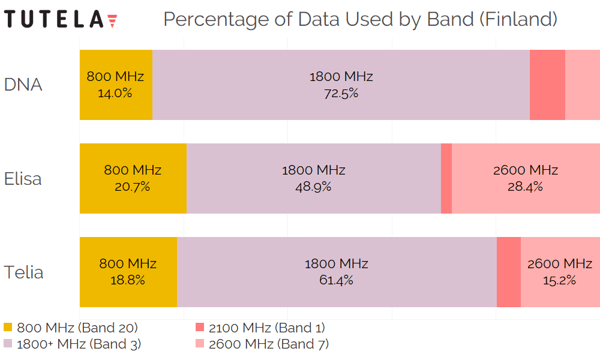| Chapter 1 Key findings |
Chapter 4 Data usage |
| Chapter 2 Coverage |
Chapter 5 Consistent quality |
| Chapter 3 Spectrum utilization |
Across Scandinavia
Thanks to Tutela’s unique approach to crowdsourced data, we can see not only what spectrum operators have deployed, but how heavily subscribers use different bands for data transfer. The chart above shows the percentage volume of data transferred by spectrum band; given the demographic similarities between Nordic countries, it can provide insight into the differing infrastructure approaches taken by countries.
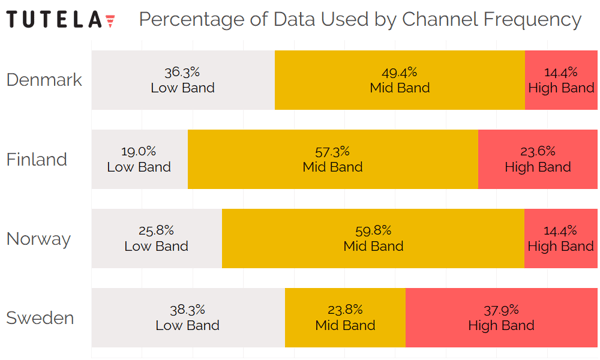
For example, we can see that Norwegian and Finnish carriers use mid-band spectrum -- specifically, the 1800 MHz band -- to handle the majority of data traffic. Sweden and Denmark use a more balanced mix of spectrum, with some Swedish operators relying particularly on the 2600 MHz spectrum. Breaking it down further, we can see spectrum utilization on an operator-by-operator basis.
Sweden 
3 uses the 800 MHz spectrum heavily, accounting for over half of its data usage. Tele2 and Telenor -- which share networks -- are both much more diverse, with a mix of 800 MHz and 900 MHz for low-band, while relying on 2600 MHz for large amounts of their total data volume.
The low volume of data transferred over 1800 MHz is surprising, given that the shared network owns 70 MHz of 1800 MHz spectrum, but it does suggest that there is underutilized capacity for future expansion. Telia, on the other hand, uses the 1800 MHz band much more than its competitors.
3 only has 20 MHz of 800 MHz spectrum, but it carries the majority of its data at present. As 3 hopes to grow its subscriber base, it has significant room in higher bands for expansion. It owns 40 MHz of 2100 MHz spectrum and 70 MHz in 2600, including a 50 MHz TDD holding. Adding capacity with higher bands requires more, smaller cell sites due to the higher bands’ shorter range, but with the industry increasingly looking to high-band spectrum as the 5G future, 3’s high-band spectrum holdings will only become more valuable.
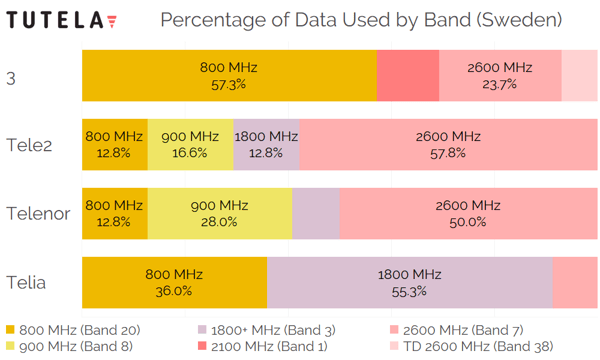
Denmark 
In Denmark, the picture for 3 is very different: it holds 60 MHz of 1800 MHz spectrum, which it is using to carry the vast majority of its data traffic. Again, it has room for further capacity growth: 45 MHz of 2600 MHz spectrum and 30 MHz of 2100 MHz spectrum, which at present carries not even 5% of the network’s traffic.
However, 3 is a major outlier in Denmark. The other networks employ a more balanced spectrum approach, with a mix of 800, 1800, 2100, and 2600 MHz used.
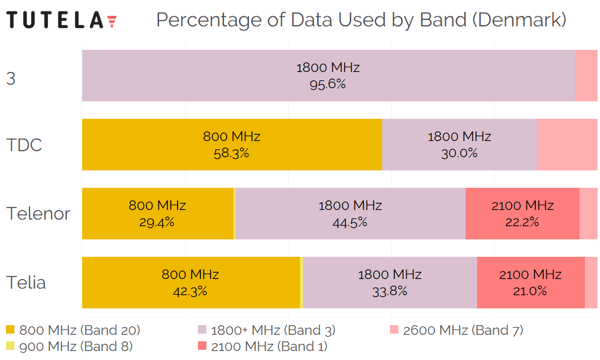
Norway 
In Norway, the two major MNOs (Telia and Telenor) both use 1800 MHz most heavily, largely using 800 MHz for additional coverage and high-band spectrum for additional capacity in some urban areas. The potential for future capacity additions via high-band spectrum is there, particularly for Telenor, which owns 120 MHz of spectrum in 2100 MHz and 2600 MHz.
For ICE, however, the picture is a little less positive. The majority of its data is transferred over 800 MHz, where it owns just 20 MHz of spectrum. Future capacity expansion on 800 MHz via the addition of more cell sites will also be challenging, given that ICE’s network is focused on urban areas.
There is potential in 1800 MHz expansion, however. ICE owns double the amount of spectrum in 1800 MHz that it does in 800 MHz, and as the other operators have demonstrated, 1800 MHz is an ideal LTE carrier for most situations. As Norway’s regulator auctions off high-band spectrum for 5G purposes, however, ICE will need to bid against the incumbents for higher-band spectrum if it hopes to grow its subscriber base with a competitive 5G offering.
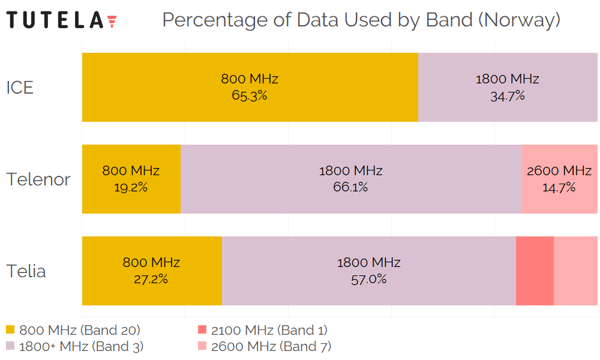
Finland 
All three Finnish carriers primarily use 1800 MHz as the backbone of their networks, with some 800 MHz usage for rural coverage. Elisa uses 2600 MHz most heavily, although all four carriers have 2100 MHz and 2600 MHz spectrum deployed.
Finland has the highest rate of mobile data usage per subscriber in the world, and also has a relatively high penetration of fixed wireless access. What stands out is how Finland’s spectrum usage is similar to other countries with far less data usage: despite the heavier load on the mobile networks, more spectrum has not yet been deployed as a solution for capacity.
With high-band spectrum currently playing only a limited role in the data transfer for all three networks, the spectrum resources should not be a limiting factor in expanding network capacity to keep up with future demand.
